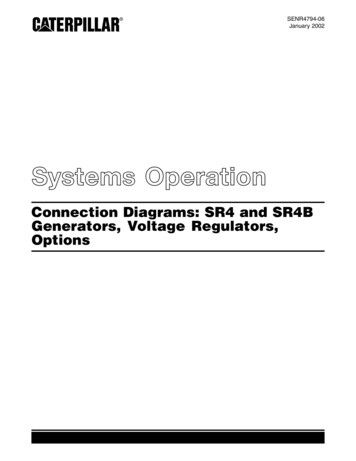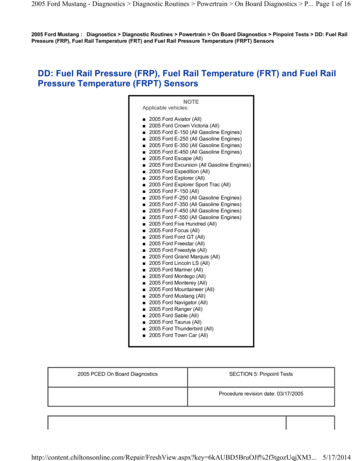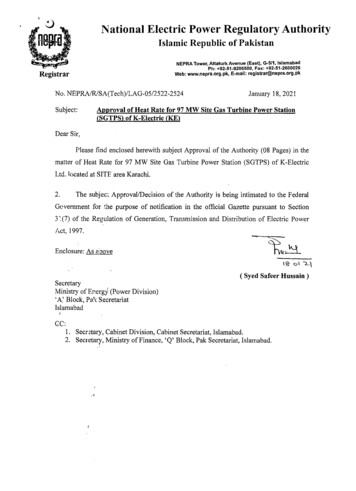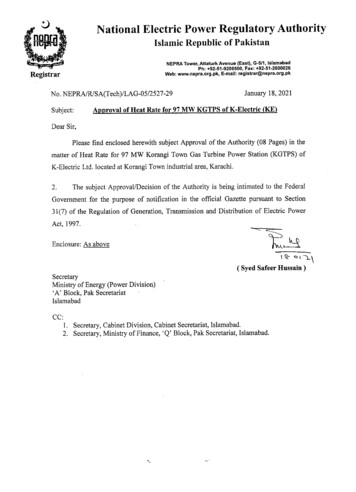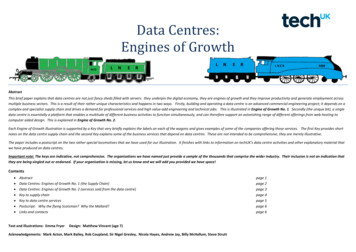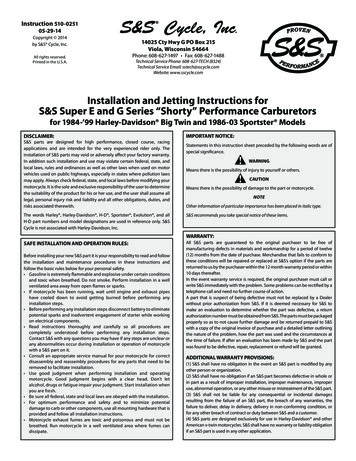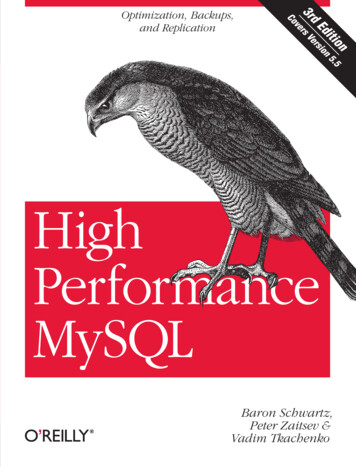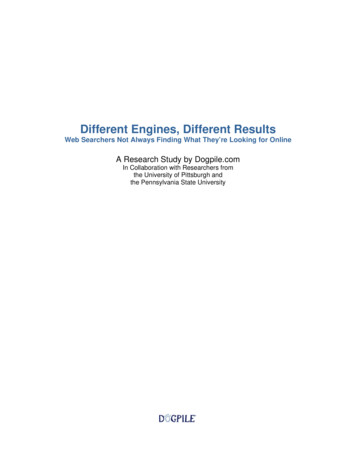
Transcription
Different Engines, Different ResultsWeb Searchers Not Always Finding What They’re Looking for OnlineA Research Study by Dogpile.comIn Collaboration with Researchers fromthe University of Pittsburgh andthe Pennsylvania State University
Different Engines, Different ResultsExecutive SummaryIn April 2005, Dogpile.com (operated by InfoSpace, Inc.) collaborated with researchers from theUniversity of Pittsburgh (http://www.sis.pitt.edu/ aspink/) and the Pennsylvania State University(http://ist.psu.edu/faculty pages/jjansen/) to measure the overlap and ranking differences of theleading Web search engines in order to gauge the benefits of using a metasearch engine to searchthe Web. The study evaluated the search results from 10,316 random user-defined queries across asample of search sites. The results found that only 3.2% of first page search results were the sameacross the top three search engines for a given query.The second phase of this overlap research was conducted in July 2005 by Dogpile.com andresearchers from the University of Pennsylvania and the Pennsylvania State University. This studyadded the recently launched MSN search to the evaluation set of Google, Yahoo! and Ask Jeevesand measured 12,570 user-entered search queries. The results from this latest study highlight the factthere are vast differences between the four most popular single search engines. The overlap acrossthe first page of search results from all four of these search engines was found to be a staggering1.1% on average for a given query. This paper provides compelling evidence as to why a metasearchengine provides end users with a greater chance of finding the best results on the Web for their topicof interest.There is a perception among users that all search engines are similar in function, deliver similarresults and index all available content on the Web. While the four major search engines evaluated inthis study, Google, Yahoo!, MSN and Ask Jeeves do scour significant portions of the Web and providequality results for most queries, this study clearly supports the last overlap analysis conducted in April2005. Namely, that each search engine’s results are still largely unique. In fact, a separate studyconducted in conjunction with comScore Media Metrix found that between 31 – 56% of all searcheson the top four search engines are converted to a click on the first result page.1 With just over half ofall Web searches resulting in click-through on the first results page from the top four Web SearchEngines at best, there is compelling evidence that Web searchers are not always finding what theyare looking for with their search engine.While Web searchers who use engines like Google, Yahoo!, MSN and Ask Jeeves may notconsciously recognize a problem, the fact is that searchers use, on average, 2.82 search engines permonth. This behavior illustrates a need for a more efficient search solution. Couple this with the factthat a significant percentage of searches fail to elicit a click on a first page search result, and we caninfer that people are not necessary finding what they are looking for with one search engine. Byvisiting multiple search engines, users are essentially metasearching the Web on their own. However,a metasearch solution like Dogpile.com allows them to find more of the best results in one place.Dogpile.com is a clear leader in the metasearch space. It is highest-trafficked metasearch site on theinternet (reaching 8.5 million people worldwide3) and is the first and only search engine to leveragethe strengths of all the best single source search engines and provide users with the broadest view ofthe best results on the Web.To understand how a metasearch engine such as Dogpile.com differentiates from single source Websearch engines, researchers from Dogpile.com, the University of Pittsburgh and the PennsylvaniaState University set out to:2 of 30
Different Engines, Different Results Measure the degree to which the search results on the first results page of Google, Yahoo!,MSN, and Ask Jeeves overlapped (were the same) as well as differed across a wide range ofuser-defined search terms. Determine the differences in page one search results and their rankings (each search engine’sview of the most relevant content) across the top four single source search engines. Measure the degree to which a metasearch engine such as Dogpile.com provided Websearchers with the best search results from the Web measured by returning results that coverboth the similar and unique views of each major single source search engines.Overview of MetasearchThe goal of a metasearch engine is to mitigate the innate differences of single source search enginesthereby providing Web searchers with the best search results from the Web’s best search engines.Metasearch distills these top results down, giving users the most comprehensive set of search resultsavailable on the Web.Unlike single source search engines, metasearch engines don't crawl the Web themselves to builddatabases. Instead, they send search queries to several search engines at once. The top results arethen displayed together on a single page.Dogpile.com is the only metasearch engine to incorporate the searching power of the four leadingsearch indices into its search results. In essence, Dogpile.com is leveraging the most comprehensiveset of information on the Web to provide Web searchers with the best results to their queries.Findings Highlight Value of MetasearchThe overlap research conducted in July 2005, which measured the overlap of first page searchresults from Google, Yahoo!, MSN, and Ask Jeeves, found that only 1.1% of 485,460 first pagesearch results were the same across these Web search engines.The July overlap study expanded on the April overlap research and measured the recently launchedMSN search engine in addition to the previously measured Web search engines. Here’s where thecombined overlap of Google, Yahoo!, MSN and Ask Jeeves stood as of July 2005: The percent of total results unique to one search engine was established to be 84.9%.The percent of total results shared by any two search engines was established to be 11.4%.The percent of total results shared by three search engines was established to be 2.6%.The percent of total results shared by the top four search engines was established to be 1.1%.Note: Going forward this study will focus on the comparison of all four search enginesOther findings from the study of overlap across Google, Yahoo!, MSN and Ask Jeeves were:Searching only one Web search engine may impede ability to find what is desired.3 of 30
Different Engines, Different Results By searching only Google a searcher can miss 70.8% of the Web’s best first page searchresults.By searching only Yahoo! a searcher can miss 69.4% of the Web’s best first page searchresults.By searching only MSN a searcher can miss 72.0% of the Web’s best first page searchresults.By searching only Ask Jeeves a searcher can miss 67.9% of the Web’s best first pagesearch results.Majority of all first results page results across top search engines are unique. On average, 66.4% of Google first page search results were unique to Google.On average, 71.2% of Yahoo! first page search results were unique to Yahoo!On average, 70.8% of MSN first page search results were unique to MSN.On average, 73.9% Ask Jeeves first page search results were unique to Ask Jeeves.Search result ranking differs significantly across major search engines. Only 7.0% of the #1 ranked non-sponsored search results where the same across allsearch engines for a given query.The top four search engines do not agree on all three of the top non-sponsored searchresults as no instances of agreement between all of the top three results were measuredin the data.Nearly one-third of the time (30.8%) the top search engines completely disagreed on thetop three non-sponsored search results.One-fifth of the time (19.2%) the top search engines completely disagreed on the top fivenon-sponsored search results.Yahoo! and Google have a low sponsored link overlap. Only 4.7% of Yahoo! and Google sponsored links overlap for a given query.For 15.0 % of all queries Google did not return a sponsored link where Yahoo! returnedone or more.For 14.5% of all queries Yahoo! did not return a sponsored link where Google returnedone or more.In addition to the overlap results from all four Web search engines, this study measured theoverlap of just Google, Yahoo! and Ask Jeeves to compare to the results from the April 2005study. Findings include:The overlap of between Google, Yahoo!, and Ask Jeeves fluctuated from April to July 2005.Period over period the percentage of unique results on each of these engines grew slightly.First page search results from the top Web search engines are largely unique. The percent of total results unique to one search engine grew slightly to 87.7% (up from84.9%).4 of 30
Different Engines, Different Results The percent of total results shared by any two search engines declined to 9.9%, downfrom 11.9%.The percent of total results shared by three search engines declined to 2.3%, down from3.2%.It is noteworthy that both Yahoo! and Google conducted major index updates in-between thesestudies which most likely effected overlap, a trend that will most likely continue as each enginecontinues to improve upon their crawling and ranking technologies.In order to get the best quality search results from across the entire Web, it is important to searchmultiple engines, a task Dogpile.com makes efficient and easy by searching all the leading enginessimultaneously and bringing back the best results from each.5 of 30
Different Engines, Different ResultsTable of ContentsExecutive Summary. 2Introduction . 7Background. 7Relevancy Differences. 9The Parts of a Crawler-Based Search Engine. 9Major Search Engines: The Same, But Different. 10Search Engine Overlap Studies. 10Search Result Overlap Methodology . 10Rationale for Measuring the first Result Page: . 10How Query Sample was Generated . 11How Search Result Data was Collected . 11How Overlap Was Calculated. 12Explanation of the Overlap Algorithm . 12Findings . 13Average Number of Results Similar on First Results Page . 13Low Search Result Overlap on the First Results Page Across Google, Yahoo!, MSN Search andAsk Jeeves . 13Searching Only One Web Search Engine may Impede Ability to Find What is Desired. 14Sponsored Link Matching Differs. 14Majority of all first Results Page Results are Unique to One Engine . 15Majority of all First Results Page Non-Sponsored Results are Unique to One Engine. 15Yahoo! and Google Have a Low Sponsored Link Overlap . 15Search Result Ranking Differs Across Major Search Engines . 16Overlap Composition of First Page Search Results Unique to Each Engine. 16Support Research – Success Rate. 17What Metasearch Engine Dogpile.com Covers . 18Implications. 20Implications for Web Searchers. 20Implications for Search Engine Marketers . 20Implications for Metasearch. 21Conclusions . 21Resources. 22Appendix A . 23Control Analysis. 23Appendix B . 25Yahoo! Non-Sponsored Search Results. 25Google Non-Sponsored Search Results. 25MSN Search Non-Sponsored Search Results. 26Ask.com Non-Sponsored Search Results . 26Yahoo! Sponsored Search Results. 27Appendix C . 28Google Sponsored Search Results . 28Ask.com Sponsored Search Results . 29MSN Search Sponsored Search Results. 306 of 30
Different Engines, Different ResultsIntroductionOver the past 18 months, the Web search industry has undergone profound changes. Heavyinvestment in research and development by the leading Web search engines has greatly improved thequality of results available to searchers. Earlier this year marked the fourth major entry into thesearch market with the launch of MSN’s search index. The rapid growth of the Internet, coupled withthe desire of the leading engines to differentiate themselves from one another gives each engine aunique view of the Web causing the results returned by each engine for the same query to differsubstantially.In this study, researchers investigated the difference in search results among four of the most popularWeb search engines using 12,570 queries and 485,460 sponsored and non-sponsored results.Results show that overlaps among search engine results are between 25-33% and that less than 20%of the time engines agree on any of the top five ranked search results. These findings have a directimpact on search engine users seeking the best results the Web has to offer. For individuals, itmeans that no single engine can provide the best results for each of their searches, all of the time.To quantify the overlap of search results across Google, Yahoo!, Ask Jeeves and MSN Search, weperformed the same query at each Web search engine, captured and stored first results page searchresults from each of these search engines across a random sample of 12,570 user-entered searchqueries. For this study, a user-entered search query is a full search term/phrase exactly as it wasentered by an end-user on any one of the InfoSpace Network powered search properties. Querieswhere not truncated and the list of 12,570 was de-duplicated so there were no duplicate queriesmeasured.BackgroundToday, there are many search engine offerings available to Web searchers. comScore Media Metrixreported 166 search engines online in May 20054. With 84.2%5 of people online using a searchengine to find information, searching is the second most popular activity online according to a PewInternet study of search engine users (2005)5.Search engines differ from one another in two primary ways – their crawling reach and frequency orrelevancy analysis (ranking algorithm).Web Crawling DifferencesThe Web is infinitely large with millions of new pages added every day.Statistics from Google.com, Yahoo.com, Cyberatlas and MIT current to April 2005 estimate: 45 billion static Web pages are publicly-available on the World Wide Web. Another estimated 5billion static pages are available within private intranet sites.200 billion database-driven pages are available as dynamic database reports ("invisible Web"pages).7 of 30
Different Engines, Different ResultsEstimates from researchers at the Università di Pisa and University of Iowa put the indexed Webat11.5 billion pages7 with other estimates citing an additional 500 billion non-indexed and invisibleweb pages yet to be indexed.8Taking a look back, the amount of the Web that has been indexed since 1995 has changeddramatically.Billions Of Textual Documents IndexedDecember 1995-September 2003Fig. 1Key : GG Google ATW AllTheWeb INK Inktomi (now Yahoo!) TMA Teoma (not Ask Jeeves)AV Alta Vista (now Yahoo!) Source: Search Engine Watch, January 28, 2005.Today, the indices continued to grow. The size of the Web, and the fact that content is ever changingmakes it difficult for any search engine to provide the most current information in real- time. In orderto maximize the likelihood that a user has access to all the latest information on a given topic, it isimportant to search multiple engines.Based on a recent study conducted by A. Gulli and A.Signorini7 there is a considerable amount of theWeb that is not indexed or covered by any one search engine. Their research estimates the visibleWeb (URLs search engines can reach) to be more than 11.5 billion pages, while the amount that hasbeen indexed to date to be roughly 9.4 billion pages.SearchEngineGoogleYahoo!AskMSN (beta)Indexed WebTotal WebSelfReportedSize(Billions)8.14.2 f IndexedWeb (%)Coverageof TotalWeb .446.144.3N/AN/ANote: “Indexed Web” refers to the part of the Web considered to have beenindexed by search engines.Fig. 2 Source: A. Gulli & A. Singorini, 20058 of 30
Different Engines, Different ResultsRelevancy DifferencesRelevancy analysis is an extremely complex issue, and developments in this area represent some ofthe most significant progress in the industry. The problem with determining relevancy is that twousers entering the very same keyword may be looking for very different information. As a result, oneengine’s determination of relevant information may be directly in the line with a user’s intent whileanother engine’s interpretation may be off-target. A goal of any search engine is to maximize thechances of displaying a highly ranked result that matches the users’ intent. With known differences incrawling coverage it is necessary for users to query multiple search engines to obtain the bestinformation for their query.While no search engine can definitively know exactly what every person intends when they search, asearcher’s interaction with the results set can help in determining how well an engine does atproviding good results. Dogpile.com in conjunction with comScore Media Metrix devised a measurefor tracking searcher click actions after a search is entered and quantifying: If a searcher clicks one or more search resultsThe page which a user clicked a search resultThe volume of clicks on search results generated for each searchA search that results in a click implies that a search result of value was found. Searches that result ina click on the first result page implies the search engine successfully understood what the user waslooking for and provided a highly-ranked result of value. Searches that result in multiple clicks implythat the search engine found multiple results of value to the user.This paper presents the results of a study conducted to quantify the degree to which the top resultsreturned by the leading engines differ from one another as well as how well Dogpile.com’smetasearch technology mitigates these differences for Web searchers. The numbers show a strikingtrend that the top-ranked results returned by Google, Yahoo!, MSN Search and Ask Jeeves arelargely unique. This study chose to focus on these four engines because they are the largest searchentities that operate their own crawling and indexing technology and together comprise 89.0%9 of allsearches conducted in the United States.The Parts of a Crawler-Based Search EngineCrawler-based search engines have three major elements. First is the spider, also called the crawler.The spider visits a Web page, reads it, and then follows links to other pages within the site. This iswhat is commonly referred to as a site being "spidered" or "crawled”. The spider returns to the site ona monthly or bi-monthly basis to look for changes.Everything the spider finds goes into the second part of the search engine, the index. The index,sometimes called the catalog, is like a giant book containing a copy of every Web page that the spiderfinds. If a Web page changes, then this index is updated with new information.Sometimes it can take a while for new pages or changes that the spider finds to be added to theindex. Thus, a Web page may have been "spidered" but not yet "indexed." Until it is indexed – (addedto the index) -- it is not available to those searching with the search engine.9 of 30
Different Engines, Different ResultsThe third part of a search engine is the search engine software that sifts through the millions of pagesrecorded in the index to find matches to a search query and rank them in order of what it believes ismost relevant.Major Search Engines: The Same, But DifferentAll crawler-based search engines have the basic parts described above, but there are differences inhow these parts are tuned. This is why the same search on different search engines will often producedramatically different results. Significant differences between the major crawler-based search enginesare summarized on the Search Engine Features Page. Information on this page has been drawn fromthe help pages of each search engine; along with data gained from articles, reviews, books,independent research, tips from others and additional content received directly from the varioussearch engines.Source: Search Engine Watch Article, “How Search Engines Work”, Danny Sullivan, October 14,2002.Search Engine Overlap StudiesResearch has previously been done on this topic. Some much smaller studies have suggested thelack of overlap in results returned for the same queries. Web research in 1996 by Ding andMarchionini (1996) first pointed to the often small overlap between results retrieved by different searchengines for the same queries. And in 1998, Lawrence and Giles (1998) showed that a single Websearch engines indexes no more than 16% of all Web sites.Search Result Overlap MethodologyRationale for Measuring the first Result PageThis study set out to measure the first result page of search engines for the following reasons: According to Dogpile.com, the majority of search result click activity (89.8%) happens on thefirst page of search results10. For this study a click was used as a proxy for interest in a resultas it pertained to the search query. Therefore, measuring the first result page captures themajority of activity on search engines.Additionally, the first result page represents the top results an engine found for a givenkeyword and is therefore a barometer for the most relevant results an engine has to offer.10 of 30
Different Engines, Different ResultsHow Query Sample was GeneratedTo ensure a random and representative sample, the following steps were taken to generate the querylist:1. Pulled 12,570 random keywords from the Web server access log files from the InfoSpacepowered search sites. These key phrases were picked from one weekday and one weekendday of the log files to ensure a more diverse set of users.2. Removed all duplicate keywords to ensure a unique list3. Removed non alphanumeric terms that are typically not processed by search engines.How Search Result Data was CollectedA. Compiled 12,570 random user-entered queries from the InfoSpace powered network of searchsite log files.B. Built a tool that automatically queried various search engines, captured the result links fromthe first result page and stored the data. The tool was a .NET application that queried Google,Yahoo!, Ask Jeeves (Ask.com), and MSN Search over http and retrieved the first page ofsearch results. Portions of each result (click URLs) were extracted using regular expressionsthat were configured per site, normalized, and stored in a database, along with someinformation like position of the result and if the result was a sponsored result or not.C. For each keyword in the list (the study used 12,570 user entered keywords), each engine ofinterest (Google, Yahoo!, Ask Jeeves (Ask.com), and MSN Search) was queried in sequence(one after another for each keyword).a. Query 1 was ran on Google – Yahoo! - Ask.com – MSN Searchb. Query 2 was run on Google – Yahoo! - Ask.com – MSN Search, etc.If an error occurred, the script paused and retried the query until it succeeded. Grabbing thedata consisted of making an http request to the site and getting back the raw html of theresponse.Each query was conducted across all engines within less than 10 seconds. Elapsed timebetween queries was 1-2 seconds depending on if an error occurred. The reason for runningthe data this way was to eliminate the opportunity for changes in indices to impact the data.The full data set was run in a consecutive 24-36 hour window to eliminate the opportunity forchanges in indices to impact results.D. Captured the results (non-sponsored and sponsored) from the first result page and stored thefollowing data in a data base:a. Display URLb. Result Position (Note: Non-Sponsored and Sponsored results have unique positionrankings because the are separated out on the results page)c. Result Type (Non-Sponsored or Sponsored)i. For Algorithmic results rankings we looked at main body results which areusually located on the left hand side of the results page. See Appendix B.11 of 30
Different Engines, Different Resultsii. For sponsored result rankings the study looked at the shaded results at the topof the results page, right-hand boxes usually labeled ‘Sponsored Results/Links’,and the shaded results at the bottom of the results page for Google andYahoo!. Ask.com sponsored results are found at the top of the results page in abox labeled ‘Sponsored Web Results’. See Appendix C.How Overlap Was CalculatedAfter collecting all of the data for the 12,570 queries, we ran an overlap algorithm based off thedisplay URL for each result. The algorithm was run against each query to determine the overlap ofsearch results by query. When the display URL on one engine exactly matched the display URL from one or moreengines of the other engines a duplicate match was recorded for that keyword.The overlap of first result page search results for each query was then summarized across all12,570 queries to come up with the overall overlap metrics.Explanation of the Overlap AlgorithmFor a given keyword, the URL of each result for each engine was retrieved from the database. ACOMPLETE result set is compiled for that keyword in the following fashion: Begin with an empty result-set as the COMPLETE result set.For each result R in engine E, if the result is not in the COMPLETE set yet, add it, and flag thatit's contained in engine X.If the result *is* in the COMPLETE set, that means it does not need to be added (it is notunique), so flag the result in the COMPLETE set as also being contained by engine X (thisassumes that it was already added to the COMPLETE set by some other preceding engine).Determining whether the result is *in* the COMPLETE set or not is done by simple stringcomparisons of the URL of the current result and the rest of the results in the COMPLETE set.The end result after going through all results for all engines is a COMPLETE set of results, whereeach result in the COMPLETE set ar
leading Web search engines in order to gauge the benefits of using a metasearch engine to search the Web. The study evaluated the search results from 10,316 random user-defined queries across a sample of search sites. The results found that only 3.2% of first page search results were the same across the top three search engines for a given query.
